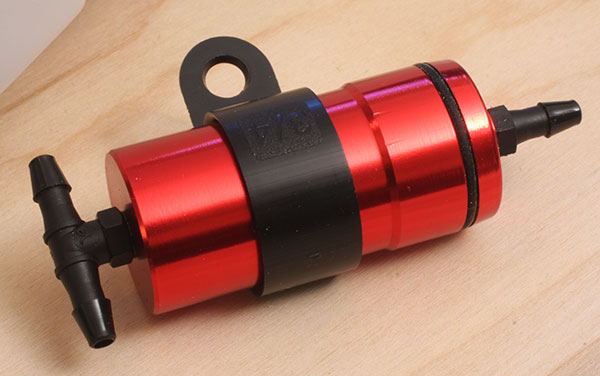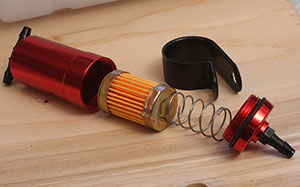



Sometimes little things can cure big problems.
Text, photos and video by Tom Hintz
Flight video by Clark Ponthier & Mike Basmajian
Posted – 3-30-2016
For our gas engines to start and perform well a reliable source of clean fuel is mandatory. The fuel passages in the RC-sized engines are too small to deal with even tiny particles of “junk” so we have a choice: filter the junk out or master the art of dead stick landings. Now there is a third choice; the QuickFire fuel filter that adds balancing of the flow of fuel throughout even highly aerobatic flights. Plus, the QuickFire comes from the folks that make the RotoFlow gas tank which gives them instant street cred with those of us using their tanks.
First and foremost, the QuickFire is a hyper efficient fuel filter. Its epic filtering capabilities come from the pleated paper automotive filter element which removes particles far smaller than normal RC filters I have tried. Plus, pleating the paper element gives it a huge surface area which lets it pass large amounts of fuel while filtering out tiny “stuff” we usually can’t even see. Because this filter element was designed for automotive use its useful life span is way longer than you might expect. You can buy replacement elements at any auto parts store for a couple dollars.
The flow of fuel is enhanced by the design of the QuickFire housing that acts like a fuel system shock absorber. The QuickFire housing stores approximately ¼-ounce of fuel that maintains a consistent flow during even the high G-force aerobatics our modern planes are capable of.
The QuickFire can also help shorten the ritual of getting a gas engine started, including one that has not run for a week or so. The QuickFire keeps an adequate supply of fuel (that ¼-ounce) at the carb which gets fuel into the carb and the reed valve body getting them “wet” so they seal better. That means stronger pumping pulses when you flip the engine which makes getting it to fire much easier and usually far sooner. It’s not magic but it will seem close when your engine starts before your arm gets tired.

I like things that are not overly complicated.
Adding the QuickFire can also clean up your fuel plumbing. The fill line goes to one of the rear connections and the other rear line goes to the tank fill port. The front line goes to the carburetor. The QuickFire itself is positioned close to and a little above the carb, often on the exterior side of the motor box.
On the Top-Flite Giant Scale P47 Razorback I have been flying I had to put the QuickFire inside the fuse at the rear edge of the motor box and run the carb line through the firewall. All that wound up approximating the described location in the instructions and it works fine.
The QuickFire comes with a plastic strap around it and a large screw used to fasten it to the structure of the plane. The 7/8" diameter, 2" length and a weight (empty) of just 14 grams gives you lots of placement options that won’t mess with the CG in a serious way.
I do have a word of caution for those expecting the QuickFire to solve all of their starting and running issues. While the QuickFire will in fact do its job very well an engine that is not tuned properly will never start easily or run reliably. However, get your motor tuned correctly and the QuickFire will make starting a cold engine or one that has sat idle during the week much easier.
The good news here is that tuning your engine is easier with the QuickFire in the system because it maintains a constant flow of fuel. You aren’t trying to tune out artificial lean or rich conditions caused by erratic fuel delivery.
The QuickFire is one of those products that can literally be forgotten because doing its job means there is nothing happening to get your attention. Your engine runs as you expect so you keep flying rather than tuning and fixing things in the fuel system.
I have a QuickFire in my Top-Flite Giant Scale P47 Razorback with a fresh EME60 engine and to date the performance has been a little scary because it has not burped, leaned out, stalled or mysteriously stopped. I can’t find an attitude where the engine will run differently either. Somewhere between the RotoFlow tank and the QuickFire fuel delivery remains constant and the engine keeps on performing without regard for its position in relation to the world.
The biggest problem the QuickFire suffers from is PR. This is one of those parts that actually does quite a bit to make a fuel system perform normally. The plane doesn’t go faster or higher, it just keeps running as we expect it to and it starts easier. If you have ever had a fuel-related issue the performance of the QuickFire will be more apparent to you.
The QuickFire comes complete with the filter element, mount and plumbing nipples. You just install it and look at it once in a while. You do have to pay $24.95 (3-29-2016) but to me that is very short money for the peace of mind the QuickFire brings to everything from war birds to your most violent 3D plane. After that you just need to replace the element every year or so and then get back to flying and still not worrying about fuel issues.
Visit the QuickFire web page - Click Here
Have a comment about this Review? –Email Me!